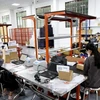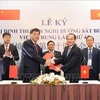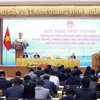Hanoi (VNA) - Strengthening the capacity for water resources management remains a key objective in the restructuring of Vietnam’s agricultural sector, said Deputy Minister of Agriculture and Rural Development Hoang Van Thang in a workshop on water resource management in Hanoi on December 18.
As Vietnam is an agriculture-based country, the management of water resources has a significant impact on the livelihood of millions of its people and therefore must be prioritised and improved with a focus on disaster risk reduction and adaptation to climate change, according to the Deputy Minister.
He said the restructuring process requires Vietnam to utilise a mix between structure based solutions such as the construction of dykes, reservoirs and other irrigation infrastructure projects and non-structure based solutions, which aimed to enhance the country's capacity in disaster management, forest replantation and flood control.
A report from the ministry's Water Resources Department indicated that measures had been taken to address some of the issues related to climate change such as decreased water supply in the Mekong Delta, including the construction of water-efficient irrigation systems and technologies in various agricultural activities.
However, the management of water resources in localities across the country still showed numerous shortcomings and limitations as provincial authorities relied too much on the local agriculture department and disaster risk management was often too structure-based, lacking solutions to gather support from local communities as well as the insufficient implementation of scientific and technological advances.
In addition, landslides, erosion and sea encroachment have become more frequent and more serious in many localities. In the last decade, a large area in the central province of Quang Nam, which consisted of populated urban zones and tourism centres, has come under threat of landslides.
Associated Prof. Nguyen Trung Viet from the Central Region College of Technology-Economics and Water Resources said that climate change and unregulated sand exploitation both contributed to an increase in the number of landslides and their severity in the province.
Viet said there was insufficient data to precisely pinpoint the root of the problem but immediate measures must be taken to reinforce the coastline, especially areas which have been known as prone to landslides such as the Cua Dai area.
Late in November, big waves and strong winds washed away a 300m section of Cua Dai Beach, 5km from Hoi An ancient town, a major tourist destination of Vietnam, in just four days in spite of local efforts to save the beach.-VNA























